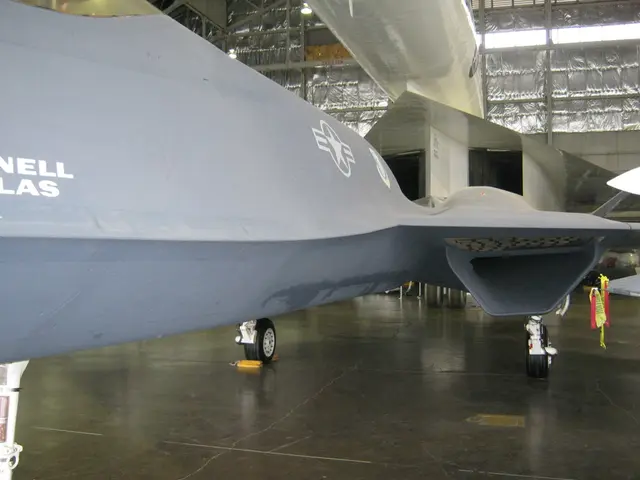Understanding Aviation Weather Reports: Decoding METAR Data and Exemplifications
Revised METAR Guide:
Mastering METAR reports is essential if you aim to pass the FAA's Part 107 test with flying colors. METAR stands for Meteorological Aerodrome Report, a standard rundown of current weather conditions at airports across the globe. This guide covers what a METAR report is, how often they're issued, and how to read them like a pro.
We've also included some METAR examples to help you grasp the information they contain and begin understanding their practical applications in aviation, whether you're flying a drone or a crewed aircraft. Get ready to dive into METAR reports.
What's the Dish on a METAR Report?
A METAR report is an observation of the current weather conditions, shared in a standard international format. It's also known as a Meteorological Terminal Aviation Routine Weather Report or just an Aviation Routine Weather Report.
When Do I Get My METAR Fix?
METARs are dished out at regular intervals, typically hourly, unless there's a significant weather change. In such cases, a Special METAR (SPECI) might be issued. These SPECIs are issued when the weather's taking a nosedive, an accident has occurred that requires quick updates, or any other extraordinary circumstances arise.
METAR vs. TAF – A Tale of Two Weather Reports
TAFs (Terminal Aerodrome Forecasts) and METARs may look alike, but they serve different purposes. TAFs provide weather predictions for a specific airport for up to 36 hours, while METARs deliver real-time weather observations. Though the formatting and weather codes are the same, becoming proficient in reading one will allow you to read the other with ease.
You Read 'Em, I Read 'Em – What Comes Next?
Now that you understand the basics, it's time to learn how to decipher a METAR report. Here's a breakdown of typical METAR report components:
- Report type (METAR or SPECI)
- Station identifier (a unique code for the airport)
- Date and time (in UTC or Zulu time)
- Modifier (indicates if the report is automated or corrected)
- Wind speed and direction (including any gusts)
- Visibility (distance the pilot can see in statute miles)
- Weather (describes current weather phenomena)
- Sky condition (reports cloud coverage, heights, and types)
- Temperature and dew point (both in degrees Celsius)
- Altimeter setting (pressure setting for altimeters in inches of mercury)
- Remarks (additional information, such as wind data, variable visibility, or maintenance needs)
Test Your Knowledge with METAR Examples
Ready to see how well you've learned to read a METAR report? Here are some METAR examples, followed by their readings:
Example 1: METAR KORD 251200Z 35005KT 5SM -RA BR BKN015 OVC025 07/05 A2992 RMK AO2 SLP134Reading:
- METAR KORD is a routine weather observation for Chicago O'Hare International Airport (KORD) in Chicago, IL
- 251200Z indicates the observation was taken on the 25th of the month at 1200 UTC (Z)
- 35005KT means the wind is from 350° true at 5 knots
- 5SM means the visibility is 5 statute miles
- -RA BR means light rain and mist
- BKN015 OVC025 indicates a ceiling of 1,500 ft broken, and 2,500 ft overcast
- 07/05 means the temperature is 7°C and the dew point is 5°C
- A2992 represents the altimeter setting of 29.92 in. of Hg
- RMK AO2 SLP134 indicates remarks: automatic observation with precipitation discriminator, sea-level pressure 134 hundredths of an inch Mercury
Example 2: METAR KLAX 221530Z 27010KT 10SM FEW020 SCT100 18/10 A3012 RMK AO2 SLP200Reading:
- METAR KLAX is a routine weather observation for Los Angeles International Airport (KLAX) in Los Angeles, CA
- 221530Z indicates the observation was taken on the 22nd of the month at 1530 UTC (Z)
- 27010KT means the wind is from 270° true at 10 knots
- 10SM means the visibility is 10 statute miles
- FEW020 SCT100 means few clouds at 2,000 ft and scattered clouds at 10,000 ft
- 18/10 means the temperature is 18°C and the dew point is 10°C
- A3012 represents the altimeter setting of 30.12 in. of Hg
- RMK AO2 SLP200 indicates remarks: automatic observation with precipitation discriminator, sea-level pressure 200 hundredths of an inch Mercury
When Do I Need a METAR?
For drone pilots flying commercially, METARs play a vital role in ensuring safe and compliant flights. They help assess wind speed and direction, visibility, and precipitation conditions to ensure that they are suitable for safe drone operations. Pick up a METAR report before and during your flights to stay ahead of the weather game.
When it comes to the FAA Part 107 test, METARs are just one of many topics that drone pilots must conquer to obtain their commercial drone license. Prepare for success with our easy-to-follow video lessons.
Kick back, relax, and hit us up for more Part 107 test prep here.
- METAR reports are essential for drone pilots seeking to pass the FAA's Part 107 test successfully, as they provide real-time weather observations for safe flight operations.
- Drone pilots require METARs to assess wind speed, direction, visibility, and precipitation conditions before and during their flights to maintain a safe and compliant operation.
- In the drone industry, aeronautical knowledge, including understanding METAR reports, is crucial for drone pilots to secure a commercial drone license, which requires passing the FAA's Part 107 test.
- Drones operate within the aviation sector and share the sky with crewed aircraft, emphasizing the need for proper weather knowledge through METAR reports.
- The FAA Part 107 test includes various topics, such as METAR reports, to scrutinize drone pilots' aeronautical knowledge, aimed at maintaining safety standards in the transportation and aerospace technology sectors.
- By learning to read METAR reports, drone pilots can enhance their financial prospects in the thriving UAS (Unmanned Aerial System) industry, which relies heavily on accurate weather data for airborne operations.
- METAR reports are valuable in the aviation industry, whether a person is piloting a drone or a crewed aircraft, as they present a standardized means of communicating current weather conditions for safe and efficient flight operations.








